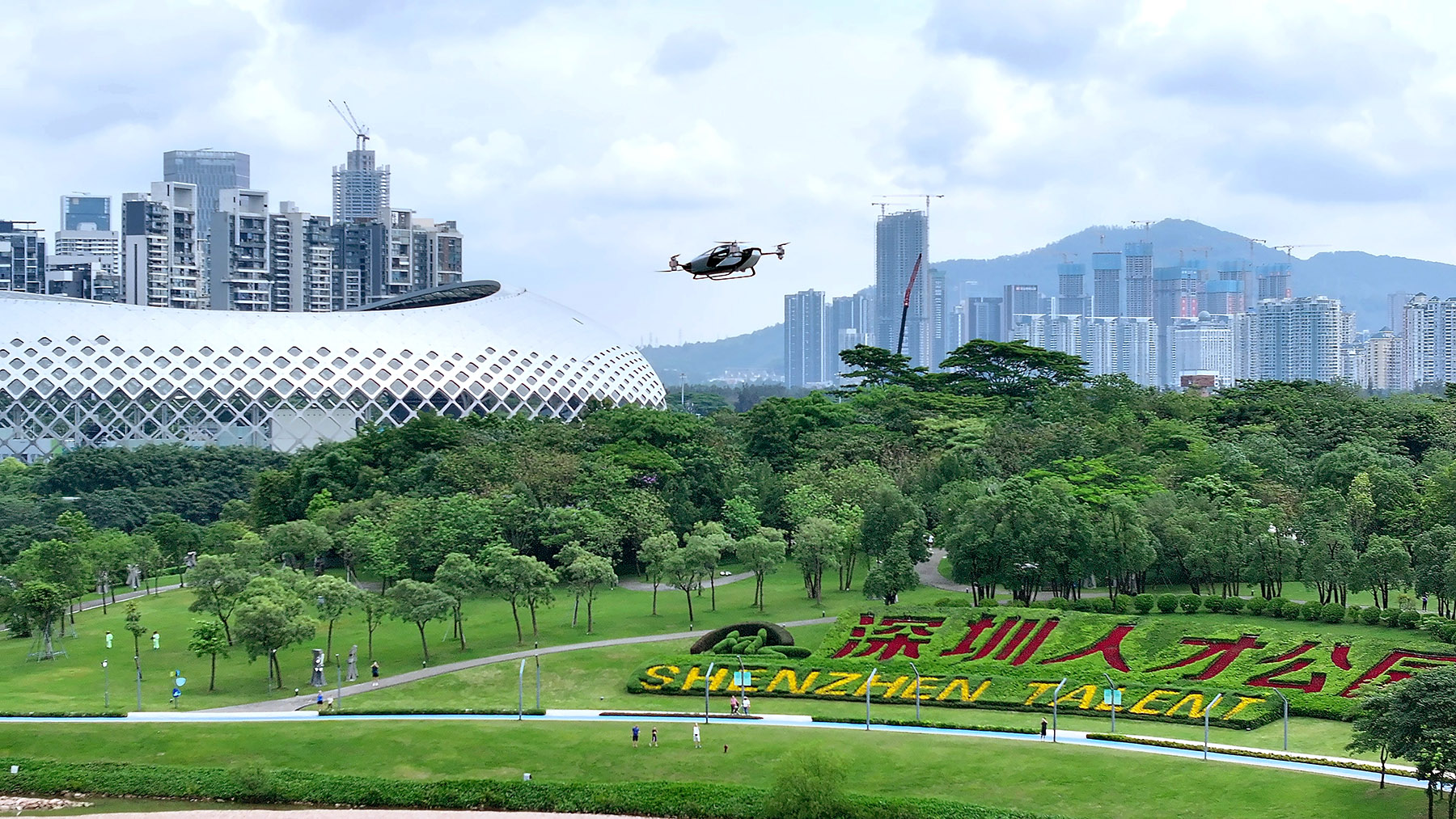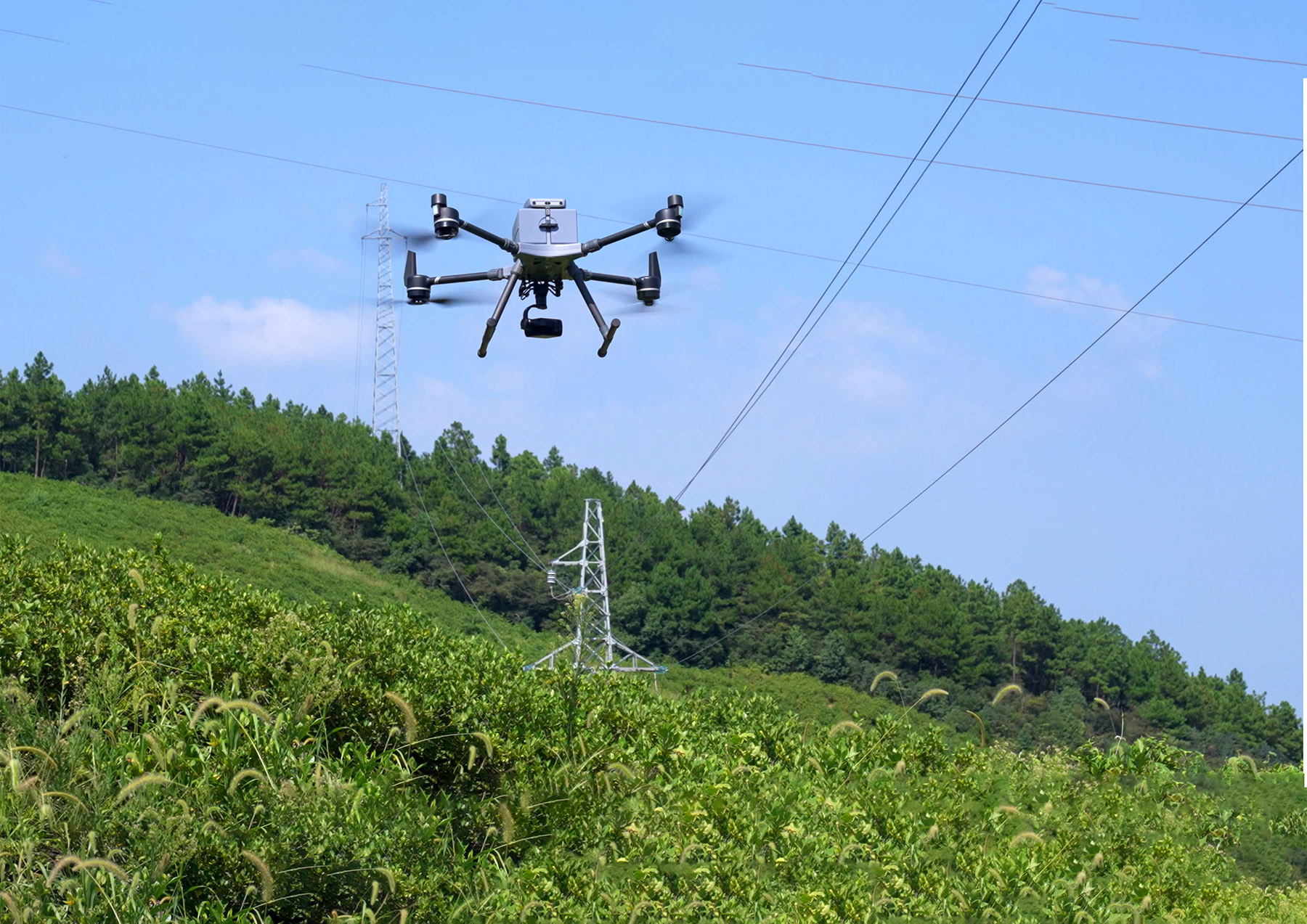Government plan to link up aviation equipment with people's jobs, lives by 2030 will boost nascent industry

On May 25, XPeng Aeroht, a leading player in the aerial mobility industry, let its flying car, the X2, fly over the Shenzhen central business district in Guangdong province for the first time, giving a sneak peek into the future of urban transportation.
The event was a milestone not only for XPeng Aeroht, an affiliate of Chinese smart carmaker Xpeng, but also for the burgeoning low-altitude economy in China.
Its X2, a two-seater electric vertical takeoff and landing aircraft, took off vertically from Shenzhen's talent park square, flying around the park at an altitude of 30 meters. The vehicle, designed and manufactured by XPeng Aeroht, operated entirely in autonomous mode, providing a bird's-eye view of Shenzhen's landmark buildings.
Before this public unveiling, the X2 had undergone nearly 6,000 test flights in various environments, including CBDs, coastal areas, deserts, and rivers, ensuring its reliability and safety in different conditions.
Shenzhen is committed to advancing new economic sectors, including the low-altitude economy and smart connected vehicles, the municipal government said in its 2024 transport work report.
READ MORE: Firms have high hopes for low-altitude biz
This initiative aims to leverage "small scene innovation" to drive "large industry development", accelerating the establishment of a "Sky City" with integrated low-altitude management, panoramic applications, and industrial clustering.
Eyeing the big opportunity, XPeng Aeroht said it is currently focused on developing its first mass-production model, the "Land Aircraft Carrier", a modular flying car expected to revolutionize personal transportation.
The Land Aircraft Carrier comprises two main parts: a ground vehicle and a flying module. The ground vehicle can house the flying module for terrestrial travel and can seamlessly transition into a flying car, the company said.
"Pre-orders for the Land Aircraft Carrier are set to begin in the fourth quarter of 2024, with production and deliveries planned for the fourth quarter of 2025. The estimated price for this innovative vehicle is over 1 million yuan ($138,000)," said Zhao Deli, founder and president of XPeng Aeroht.
XPeng Aeroht's daring mirrors a broader trend and enthusiasm for the low-altitude economy in China.
Though an official definition has yet to be agreed upon, the concept of a "low-altitude economy" is generally understood by economists as a range of business activities occurring within airspace up to 1,000 meters above ground.
It encompasses both manned and unmanned civilian aircraft operations. These activities include passenger transportation, air tourism, cargo delivery as well as the manufacturing, maintenance and integrated services associated with related equipment.
In March, the Ministry of Industry and Information Technology and three other ministerial-level departments unveiled an ambitious plan to form a trillion-yuan-level market in general aviation equipment.
The plan to integrate general aviation equipment comprehensively into people's jobs and daily lives by 2030 will give a strong boost to the development of the low-altitude economy, including eVTOL aircraft, experts said.

The plan aims to capitalize on advancements in unmanned, electric and intelligent technologies to propel the commercial application of new-generation general aviation equipment in urban air transportation, logistics distribution and emergency rescue operations.
China is seeking to lead in the development of green and intelligent general aviation aircraft, positioning itself at the forefront of global innovation.
Wu Peixin, an independent aviation industry analyst in Beijing, said this is the latest signal from the Chinese government that the country attaches great importance to the development of the low-altitude economy.
According to the plan, key initiatives include the establishment of joint laboratories, technology innovation centers and tech innovation service platforms in the general aviation sector. Additionally, efforts will be directed toward laying the groundwork for a robust regulatory and safety verification system, while demonstrating the tangible benefits of aviation emergency rescue and logistics distribution on a large scale.
By 2030, China aims to establish a new model for the development of the general aviation industry characterized by high-end, intelligent and green features. This model will support and ensure the safe and efficient operation of various networks, including passenger transportation, drone delivery and low-altitude production operations, thus fueling low-altitude economic growth and forming a trillion-yuan-level market scale.
China will also support the development of smart air mobility equipment, such as eVTOL, to meet the evolving needs of consumers, the plan said.
As an active participant in this new economy, XPeng Aeroht said it aims to facilitate urban low-altitude commuting and sightseeing, contributing valuable insights for the future of three-dimensional urban transportation.
On June 1, the construction of a tourism town featuring low-altitude economy began in Jiangmen, a city in Guangdong province, and the project signed a procurement agreement with XPeng Aeroht for 100 Land Aircraft Carriers.
The preorders were secured with advance payment, marking a significant step in integrating flying cars into the low-altitude tourism sector.
Founded in 2013, XPeng Aeroht has grown into Asia's largest flying car company and an integral part of XPeng Motors' ecosystem. The company aims to integrate intelligent automotive and modern aviation technologies to create the safest electric flying cars for personal use.
With its research and development center and flight test base located in Guangzhou, Guangdong province, and advanced flying car laboratories in Shenzhen and Shanghai, XPeng Aeroht is at the forefront of the eVTOL industry. The company has developed six generations of eVTOL vehicles, completing over 15,000 test flights.
The market scale of China's low-altitude economy, which is regarded as a strategic emerging industry, reached 505.95 billion yuan in 2023, up 33.8 percent year-on-year, and is expected to surpass 1 trillion yuan in 2026, according to a new report by market research firm CCID Consulting.
Revenues from eVTOL aircraft rose 77.3 percent year-on-year to 980 million yuan last year, the report said. This segment is poised to see wider commercial application in fields like aerial sightseeing and tourism in 2024.
The report estimates that the eVTOL industry will maintain rapid growth in the next few years, with the market scale hitting 9.5 billion yuan in 2026, fueled by the speedy issuance of airworthiness certifications by authorities.
Industry-level drones are finding applications in a wide range of fields, such as emergency rescue work, power line patrolling, farming, and surveillance and security operations, it added.
"A decade ago, the consumer drone industry boomed. Today, industrial drones are on the rise. In 10 years, the aviation-grade drone market will inevitably explode," said Tian Gangyin, founder, chairman and president of the Chinese unmanned aerial vehicle developer, United Aircraft.
ALSO READ: Eye in sky nets big fame for village
The company debuted its Q100 agricultural drone at an exhibition in Shenzhen in May. It boasts a maximum spray load of 50 kilograms, and is capable of covering 400 mu (26.7 hectares) in an hour. It can effectively guard against pesticide corrosion, can be washed entirely, and offers greater efficiency and convenience. Its intelligent route planning and one-click autonomous operation make it a formidable asset in spraying pesticide, transportation, and aerial surveying, United Aircraft said.
The agility, efficiency, safety, and risk reduction features of drones have seen extensive application in emergency rescue and firefighting, Tian said.
The TD550 all-scenario emergency firefighting drone helicopter, showcased by United Aircraft, demonstrates large load capacity, long endurance, multifunctionality, high speed, and precise hovering in firefighting, material delivery, and emergency communication support.
The company has also developed the TD220 power-type drone, designed specifically for the power industry. With integrated advanced sensors and autonomous flight control systems, the drone can adapt to complex grid environments, performing efficient inspections and maintenance, significantly improving the management efficiency and safety of power facilities, United Aircraft said.
"To advance the low-altitude economy, infrastructure needs to come first," Tian said, adding that more efforts are needed to accelerate the construction of infrastructure, such as takeoff and landing facilities for drones in cities.


